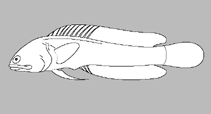http://www.fishbase.org/Summary/speciesSummary.php?genusname=Opistognathus&speciesname=brasiliensis ---> http://192.134.151.83/Summary/speciesSummary.php?genusname=Opistognathus&speciesname=brasiliensis
http://192.134.151.83/Summary/speciesSummary.php?genusname=Opistognathus&speciesname=brasiliensis ---> https://fishbase.mnhn.fr/Summary/speciesSummary.php?genusname=Opistognathus&speciesname=brasiliensis
https://fishbase.mnhn.fr/Summary/speciesSummary.php?genusname=Opistognathus&speciesname=brasiliensis ---> https://fishbase.mnhn.fr/summary/Opistognathus-brasiliensis.html
Opistognathus brasiliensis, Darkfin jawfish

You can
sponsor
this page
Common name (e.g. trout)
Genus + Species (e.g. Gadus morhua)
-

-
About this page
-
Languages
-
User feedbacks
-
Citation
-
Uploads
-
Related species
-


 Darkfin jawfish
Add your observation in
Fish Watcher
Upload your
photos
and
videos
Darkfin jawfish
Add your observation in
Fish Watcher
Upload your
photos
and
videos
Google image
 No image available for this species;
No image available for this species;
drawing shows typical species in Opistognathidae.
Teleostei (teleosts) >
Ovalentaria/misc
(Various families in series Ovalentaria) >
Opistognathidae
(Jawfishes)
Etymology:
Opistognathus:
Greek, opisthe = behind + Greek, gnathos = jaw (Ref. 45335); to the very elongate upper jaw of the type species of the genus,
Opistognathus nigromarginatus
(Ref.
128653
)
;
brasiliensis:
Named after Brazil, along whose coast this species appears to be endemic (Ref.
26893
)
.
Environment: milieu / climate zone / depth range / distribution range
Ecology
Marine; demersal; depth range 15 - 69 m (Ref.
129348
). Subtropical
Southwest Atlantic: Brazil.
Size / Weight / Age
Maturity: L
m
?
range ? - ? cm
Max length : 12.9 cm SL male/unsexed; (Ref.
26893
)
Short description
Morphology
|
Morphometrics
Dorsal
spines
(total): 11;
Dorsal
soft rays
(total): 16;
Anal
spines
: 3;
Anal
soft rays
: 15 - 16;
Vertebrae
: 28. Anterior nostril a short tube with simple cirrus on posterior rim; posterior end of maxilla of adult males produced as a thin flexible lamina that usually extends beyond posterior margin of opercle; spinous dorsal fin with black spot encircled by a very narrow white ring; dorsal fin with 5 or 6 dusky bands that extend onto dorsum; adult males with inner lining of maxilla and adjacent membranes with 2 dark stripes, one stripe in females; pectoral fin uniformly pigmented, no black speckles proximally; buccal pigmentation consisting of a dark area widely surrounding esophageal opening except for a pale area posteriorly that continues between upper pharyngeal tooth patches; caudal vertebrae 8 (Ref.
26893
).
Founf on bottoms with gravel and sand or on silt and sand bottoms, near coral reefs and rocky areas (Ref.
129348
). Mouthbrooders (Ref.
240
).
Life cycle and mating behavior
Maturity
|
Reproduction
|
Spawning
|
Eggs
|
Fecundity
|
Larvae
Employ mouthbrooding to care for their young (Ref.
240
).
Smith-Vaniz, W.F.
, 1997. Five new species of jawfishes (
Opistognathus
: Opistognathidae) from the western Atlantic ocean. Bull. Mar. Sci. 60(3):1074-1128. (Ref.
26893
)
IUCN Red List Status (Ref.
130435
)
Not Evaluated
CITES
Not Evaluated
Not Evaluated
Threat to humans
Harmless
Human uses
FAO - Publication:
search
|
FishSource
|
More information
Countries
FAO areas
Ecosystems
Occurrences
Introductions
Stocks
Ecology
Diet
Food items
Food consumption
Ration
Common names
Synonyms
Metabolism
Predators
Ecotoxicology
Reproduction
Maturity
Spawning
Spawning aggregation
Fecundity
Eggs
Egg development
Age/Size
Growth
Length-weight
Length-length
Length-frequencies
Morphometrics
Morphology
Larvae
Larval dynamics
Recruitment
Abundance
BRUVS
References
Aquaculture
Aquaculture profile
Strains
Genetics
Electrophoreses
Heritability
Diseases
Processing
Nutrients
Mass conversion
Collaborators
Pictures
Stamps, Coins Misc.
Sounds
Ciguatera
Speed
Swim. type
Gill area
Otoliths
Brains
Vision
Tools
E-book
|
Field guide
|
Length-frequency wizard
|
Life-history tool
|
Point map
|
Classification Tree
|
Catch-MSY
|
Special reports
Check for Aquarium maintenance
|
Check for Species Fact Sheets
|
Check for Aquaculture Fact Sheets
Download XML
Summary page
|
Point data
|
Common names
|
Photos
Internet sources
AFORO (otoliths) |
Aquatic Commons
|
BHL
|
Cloffa
|
BOLDSystems
|
Websites from users
|
Check FishWatcher
|
CISTI
|
Catalog of Fishes
:
genus
,
species
|
DiscoverLife
|
ECOTOX
| FAO - Publication:
search
|
Faunafri
| Fishipedia |
Fishtrace
| GenBank:
genome
,
nucleotide
| GloBI |
Google Books
|
Google Scholar
|
Google
| IGFA World Record |
MitoFish
|
Otolith Atlas of Taiwan Fishes
|
PubMed
| Reef Life Survey | Socotra Atlas |
Tree of Life
| Wikipedia:
Go
,
Search
| World Records Freshwater Fishing |
Zoobank
|
Zoological Record
Estimates based on models
Preferred temperature (Ref.
123201
): 20.2 - 23.1, mean 21.7 °C (based on 5 cells).
Phylogenetic diversity index (Ref.
82804
): PD
50
= 0.5000 [Uniqueness, from 0.5 = low to 2.0 = high].
Bayesian length-weight: a=0.00389 (0.00180 - 0.00842), b=3.12 (2.94 - 3.30), in cm total length, based on all LWR estimates for this body shape (Ref.
93245
).
Trophic level (Ref.
69278
): 3.6 ±0.6 se; based on size and trophs of closest relatives
Fishing Vulnerability (Ref.
59153
): Low vulnerability (10 of 100).
Back to Search
Random Species
Back to Top
Accessed through:
Not available
FishBase mirror site :
localhost
Page last modified by :
mrius-barile
- 20 July 2016
Fatal error
: Uncaught ArgumentCountError: Too few arguments to function checkEcotox(), 1 passed in /var/www/html/summary/speciessummary.php on line 2304 and exactly 3 expected in /var/www/html/includes/speciessummary.lib.php:2579 Stack trace: #0 /var/www/html/summary/speciessummary.php(2304): checkEcotox() #1 {main} thrown in
/var/www/html/includes/speciessummary.lib.php
on line
2579
|